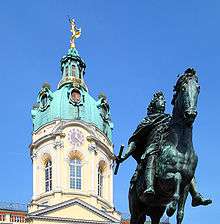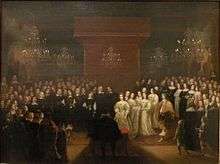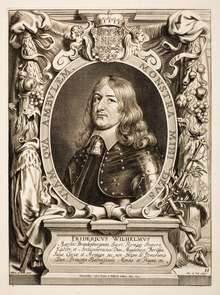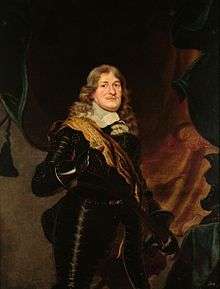Frederick William, Elector of Brandenburg
| ||||||||||||||||||||||||||||||
Frederick William (German: Friedrich Wilhelm) (16 February 1620 – 29 April 1688) was Elector of Brandenburg and Duke of Prussia – and thus ruler of Brandenburg-Prussia – from 1640 until his death. A member of the House of Hohenzollern, he is popularly known as "the Great Elector"[1] (der Große Kurfürst) because of his military and political achievements. Frederick William was a staunch pillar of the Calvinist faith, associated with the rising commercial class. He saw the importance of trade and promoted it vigorously. His shrewd domestic reforms gave Prussia a strong position in the post-Westphalian political order of north-central Europe, setting Prussia up for elevation from duchy to kingdom, achieved under his son and successor.
Biography
Elector Frederick William was born in Berlin to George William, Elector of Brandenburg, and Elisabeth Charlotte of the Palatinate. His inheritance consisted of the Margraviate of Brandenburg, the Duchy of Cleves, the County of Mark, and the Duchy of Prussia.
Foreign diplomacy
During the Thirty Years' War, George William strove to maintain, with a minimal army, a delicate balance between the Protestant and Catholic forces fighting throughout the Holy Roman Empire. Out of these unpromising beginnings Frederick William managed to rebuild his war-ravaged territories. In contrast to the religious disputes that disrupted the internal affairs of other European states, Brandenburg-Prussia benefited from the policy of religious tolerance adopted by Frederick William. With the help of French subsidies, he built up an army to defend the country. In the Second Northern War, he was forced to accept Swedish vassalage for the Duchy of Prussia according to the terms of the Treaty of Königsberg (1656),[2] but as the war progressed he succeeded in gaining full sovereignty for the Prussian duchy in the treaties of Labiau, Wehlau, Bromberg and Oliva, leaving the Holy Roman Emperor as his only liege for his imperial holdings.[3]
In the conflict for Pomerania inheritance, Frederick William had to accept two setbacks, one in the Northern War and one in the Scanian War. Though militarily successful in Swedish Pomerania, he had to bow to France's demands and return his gains to Sweden in the Treaty of Saint-Germain-en-Laye (1679).[4]
Military career

Frederick William was a military commander of wide renown, and his standing army would later become the model for the Prussian Army. He is notable for his joint victory with Swedish forces at the Battle of Warsaw (1656), which, according to Hajo Holborn, marked "the beginning of Prussian military history",[5] but the Swedes turned on him at the behest of King Louis XIV of France and invaded Brandenburg. After marching 250 kilometres in 15 days back to Brandenburg, he caught the Swedes by surprise and managed to defeat them on the field at the Battle of Fehrbellin, destroying the myth of Swedish military invincibility. He later destroyed another Swedish army that invaded the Duchy of Prussia during the Great Sleigh Drive in 1678. He is noted for his use of broad directives and delegation of decision-making to his commanders, which would later become the basis for the German doctrine of Auftragstaktik, and he is noted for using rapid mobility to defeat his foes.[6]
Domestic policies
Frederick William is notable for raising an army of 40,000 soldiers by 1678, through the General War Commissariat presided over by Joachim Friedrich von Blumenthal. He was an advocate of mercantilism, monopolies, subsidies, tariffs, and internal improvements. Following Louis XIV's revocation of the Edict of Nantes, Frederick William encouraged skilled French and Walloon Huguenots to emigrate to Brandenburg-Prussia with the Edict of Potsdam, bolstering the country's technical and industrial base. On Blumenthal's advice he agreed to exempt the nobility from taxes and in return they agreed to dissolve the Estates-General. He also simplified travel in Brandenburg and the Duchy of Prussia by connecting riverways with canals, a system that was expanded by later Prussian architects, such as Georg Steenke; the system is still in use today.
Marriages


On 7 December 1646 in The Hague, Frederick William entered into a marriage, proposed by Blumenthal as a partial solution to the Jülich-Berg question, with Luise Henriette of Nassau (1627–1667), daughter of Frederick Henry of Orange-Nassau and Amalia of Solms-Braunfels and his 1st cousin once removed through William the Silent. Their children were as follows:
- William Henry, Electoral Prince of Brandenburg (1648–1649),
- Charles, Electoral Prince of Brandenburg (1655–1674),
- Frederick I of Prussia (1657–1713), his successor,
- Amalie (1656–1664),
- Henry (1664–1664),
- Louis (1666–1687), who married Ludwika Karolina Radziwiłł.
On 13 June 1668 in Gröningen, Frederick William married Sophie Dorothea of Holstein-Sonderburg-Glücksburg, daughter of Philip, Duke of Schleswig-Holstein-Sonderburg-Glücksburg and Sophie Hedwig of Saxe-Lauenburg. Their children were the following:
- Philip William (1669–1711),
- Marie Amelie (1670–1739) married:
- Albert Frederick (1672–1731),
- Charles Philip (1673–1695),
- Elisabeth Sofie (1674–1748), who married Christian Ernst of Brandenburg-Bayreuth (6 August 1644 – 20 May 1712) on 30 March 1703.
- Dorothea (1675–1676),
- Christian Ludwig (1677–1734), recipient of Bach's Brandenburg Concertos.
Ancestry
| Ancestors of Frederick William, Elector of Brandenburg | ||||||||||||||||||||||||||||||||||||||||||||||||||||||||||||||||||||||||||||||||||||||||||||||||||||||||||||||||||||||||||||||||||||||||||||||||||||||||||||||||||||||||||||||||||||||||||||||||||||||||||||||||||||||||||||||||||||||||||||||||||||||||||||||||||||||||||||||||||||||||||||||||||||||||||||||||||||||||||||||||||||||||||||||||||
|---|---|---|---|---|---|---|---|---|---|---|---|---|---|---|---|---|---|---|---|---|---|---|---|---|---|---|---|---|---|---|---|---|---|---|---|---|---|---|---|---|---|---|---|---|---|---|---|---|---|---|---|---|---|---|---|---|---|---|---|---|---|---|---|---|---|---|---|---|---|---|---|---|---|---|---|---|---|---|---|---|---|---|---|---|---|---|---|---|---|---|---|---|---|---|---|---|---|---|---|---|---|---|---|---|---|---|---|---|---|---|---|---|---|---|---|---|---|---|---|---|---|---|---|---|---|---|---|---|---|---|---|---|---|---|---|---|---|---|---|---|---|---|---|---|---|---|---|---|---|---|---|---|---|---|---|---|---|---|---|---|---|---|---|---|---|---|---|---|---|---|---|---|---|---|---|---|---|---|---|---|---|---|---|---|---|---|---|---|---|---|---|---|---|---|---|---|---|---|---|---|---|---|---|---|---|---|---|---|---|---|---|---|---|---|---|---|---|---|---|---|---|---|---|---|---|---|---|---|---|---|---|---|---|---|---|---|---|---|---|---|---|---|---|---|---|---|---|---|---|---|---|---|---|---|---|---|---|---|---|---|---|---|---|---|---|---|---|---|---|---|---|---|---|---|---|---|---|---|---|---|---|---|---|---|---|---|---|---|---|---|---|---|---|---|---|---|---|---|---|---|---|---|---|---|---|---|---|---|---|---|---|---|---|---|---|---|---|---|---|---|---|---|---|---|---|---|---|---|---|---|---|---|---|---|---|---|---|---|
| ||||||||||||||||||||||||||||||||||||||||||||||||||||||||||||||||||||||||||||||||||||||||||||||||||||||||||||||||||||||||||||||||||||||||||||||||||||||||||||||||||||||||||||||||||||||||||||||||||||||||||||||||||||||||||||||||||||||||||||||||||||||||||||||||||||||||||||||||||||||||||||||||||||||||||||||||||||||||||||||||||||||||||||||||||
References
- ↑
 Rines, George Edwin, ed. (1920). "Great Elector, The". Encyclopedia Americana.
Rines, George Edwin, ed. (1920). "Great Elector, The". Encyclopedia Americana. - ↑ Press, Volker (1991). Kriege und Krisen. Deutschland 1600–1715. Neue deutsche Geschichte (in German). 5. Munich: Beck. pp. 401–402. ISBN 3-406-30817-1.
- ↑ Press, Volker (1991). Kriege und Krisen. Deutschland 1600–1715. Neue deutsche Geschichte (in German). 5. Munich: Beck. pp. 402ff. ISBN 3-406-30817-1.
- ↑ Clark, Christopher M. (2006). Iron kingdom: the rise and downfall of Prussia, 1600–1947. Harvard University Press. p. 50. ISBN 0-674-02385-4.
- ↑ Holborn, Hajo (1982). A History of Modern Germany: 1648–1840. A History of Modern Germany. 2. Princeton University Press. p. 57. ISBN 0-691-00796-9.
- ↑ Citino, Robert. The German Way of War. From the Thirty Years War to the Third Reich. pp 1–35. University Press of Kansas, 2005.
External links
 Media related to Friedrich Wilhelm I of Brandenburg at Wikimedia Commons
Media related to Friedrich Wilhelm I of Brandenburg at Wikimedia Commons
| Frederick William, Elector of Brandenburg Born: 16 February 1620 Died: 29 April 1688 | ||
| Regnal titles | ||
|---|---|---|
| Preceded by George William |
Elector of Brandenburg Duke of Prussia 1640–1688 |
Succeeded by Frederick III |

.png)